 Image search results - "higashi" Image search results - "higashi" |

From the Ohmi Railways' Gokasho Station, you can walk to the Fujii Hikoshiro House (藤井 彦四郎邸), which is also a history museum, and to the modern Ohmi Merchant Museum (近江商人博物館).Ohmi Railways Gokasho Station 近江鉄道五箇所駅
|
|

Gokasho is famous for the grand, old homes of wealthy Omi merchants. Three of them are clustered together for us to visit inside. They are the former residences of Tonomura Uhee (外村 宇兵衛), Tonomura Shigeru (外村 繁), and Nakae Jungoro (中江
|
|

During July-Aug. 2007, I helped to make the Yokaichi giant kite at the annex of the Yokaichi Giant Kite Museum.where the giant kite is made. Every three years, the giant kite, flown every May in Higashi-Omi, is replaced by a new kite bearing a new design.The new kite was made during July-Aug. 2007, taking about 30 days. The kite is made by volunteers from the public under the instruction of the Yokaichi Giant Kite Preservation Society. For the first time, I helped make this giant kite which was first flown successsfully on May 25, 2008 at the annual kite festival.
|
|

You can buy a set of tickets to all four Omi merchant homes and the museum which cheaper than buying a ticket at each place. Ohmi Railways Gokasho Station 近江鉄道五箇所駅
|
|

Gokasho was home to many Omi merchants who plied up and down Japan during the Edo Period to sell and trade their wares. They became quite successful selling medicines, lacquerware, sake, etc.Wall of former home of Omi merchant Tonomura Shigeru (1902-1961) (外村 繁邸).
|
|

Entrance to the annex and a sign indicating the day's event or work. Today, July 7, 2007, was the Noritsuke Pasting Ceremony. 八日市大凧まつり のりつけ式
|
|
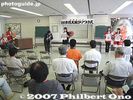
July 7, 2007: The making of the giant kite started with Noritsuke Pasting Ceremony where the new design was announced and dignitaries pasted together the first pieces of the kite paper.
|
|

Ohmi Railways Gokasho Station, waiting room.
|
|

Former home of Omi merchant Tonomura Shigeru (外村 繁邸). MapTonomura Shigeru (外村 繁), Tonomura Uhee (外村 宇兵衛), and Nakae Jungoro (中江 準五郎)
|
|

Ohmi Railways Gokasho Station building as seen from the train platform.
|
|

Entrance to former home of Omi merchant Tonomura Shigeru (外村 繁邸). Gokasho is also a National Important Traditional Townscape Preservation District (重要伝統的建造物群保存地区).
|
|

Before announcing the final kite design, they announced the three best (but not winning) design entries. The public was invited to submit kite designs based on the theme of "Life" or inochi.
|
|

Ohmi Railways Gokasho Station train platform.
|
|

Entrance to former home of Omi merchant Tonomura Shigeru.
|
|

Twenty-six design entries were submitted this year. There was no top winner, so the final design was based on the three best designs. This design features the kanji "Yorokobu" or joyfulness. 今回のテーマは「いのち」
|
|

In front of Gokasho Station is a map and stone monument. Gokasho is also a National Important Traditional Townscape Preservation District (重要伝統的建造物群保存地区).
|
|

Living room of former home of Omi merchant Tonomura Shigeru.
|
|

They introduced the three best designs. 最優秀作品はなく、3点の優秀賞作品を参考に保存会が決めた。
|
|
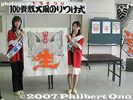
The new kite design was then announced. Called Han-jimon (判じもん), the design expresses a certain theme using word play with a pair of animals and one or two kanji characters. 八日市大凧は3年に一度図柄を変える。
|
|

Stone monument for the local Obata shonin merchants.
|
|
|
|

The top kanji is "yorokobu" (joyfulness) which can also be read as "ki." The pair of hawks 鷹 can be read as "yo." And the bottom kanji is "sei" (living). It's "Kyosei."
|
|

Road in front of the train station.
|
|
|

Old Sprite sign
|
|
|

Higashi-Omi mayor Nakamura Koichi explains the design. "Kyosei" 共生 means to co-exist (i.e. man and nature) or to live together harmoniously. 中村功一市長
|
|

Bus stop and sign to the Fujii house. Gokasho has good signs showing you the way to the Omi merchant homes.
|
|

Woman's hairdressing room.
|
|

The mayor and one of the kite design artists wear a sash and pose for a picture before proceeding with the Noritsuke Ceremony.
|
|

Higashikurume Station on the Seibu Ikebukuro Line. On the far left is the Fujimi Terrace lookout deck. 東久留米駅
|
|

Entrance to the bamboo grove at Takebayashi Park. 竹林公園
|
|
|
|

Room with Hina festival dolls and entrance to the Tonomura Shigeru Literature Museum. 雛祭りの雛人形
|
|

They used a wide brush to apply paste to the edges of a piece of kite paper.
|
|

On the west side, Higashikurume Station has a lookout deck called Fujimi Terrace to view Mt. Fuji on clear days. 富士見テラス
|
|

Higashikurume's farming homes used to each have a bamboo grove.
|
|

Gokasho is a rural town.
|
|

Hina festival dolls. 雛祭りの雛人形
|
|

They joined two sheets of kite paper together. This marked the first step in making the kite. The finished kite paper will consist of a few hundred washi paper sheets pasted together.
|
|

More dignitaries paste the sheets of kite paper together.
|
|

View of Fujimi-dori road from Fujimi Terrace. Unfortunately, too hazy to see Mt. Fuji. 「まろにえ富士見通り」
|
|

However, due to urban development, the bamboo groves were fast disappearing. So from 1974, the city decided to preserve this one bamboo grove.
|
|

Another sign.
|
|

Hina festival dolls. 雛祭りの雛人形
|
|

A nice short trail goes through the bamboo forest.
|
|

Higashikurume Station
|
|

Entrance to the former residence of Omi merchant Fujii Hikoshiro (1876-1956) (藤井 彦四郎邸)
|
|

Tonomura Shigeru Literature Museum (Bungakukan). Shigeru had a passion for writing, so he entrusted the family business to his younger brother. 外村 繁文学館
|
|

The pasted pieces are laid to dry.
|
|
|

Former residence of Omi merchant Fujii Hikoshiro (1876-1956) (藤井 彦四郎邸). Now a history museum.
|
|

Picture of Tonomura Shigeru in the Literature Museum (Bungakukan). 外村 繁文学館
|
|

We were then invited to sign our names on the kite paper.
|
|

Bamboo forest, Higashikurume, Tokyo
|
|

Omi merchant statue.
|
|

Attic
|
|

The kite design announcement and pasting ceremony lasted an hour, after which a group photo was taken.
|
|
|

Omi merchant statue.
|
|

Hina festival dolls. 雛祭りの雛人形
|
|
|

Bust of Fujii Hikoshiro
|
|

Hina festival dolls. 雛祭りの雛人形
|
|
|
|

Foyer of house 玄関
|
|

Hina festival dolls. 雛祭りの雛人形
|
|

In the bamboo forest is one of Tokyo's 57 Famous Natural Springs.
|
|

Entrance room
|
|

2nd floor balcony (Watch your head).
|
|

One of Tokyo's 57 Famous Natural Springs 竹林公園・東京の名湧水57選
|
|

Omi merchant display
|
|

2nd floor balcony
|
|

July 8, 2007: On the day after the pasting ceremony, the Kamitsugi or paper joining was next. 紙継ぎ
|
|

Clear water, but I could not find any spot where the water was gushing out.
|
|

Corridor to rooms and garden.
|
|

View from 2nd floor balcony
|
|

Starting at 9:30 am, members of the giant kite preservation society began pasting and joining about 400 sheets of washi paper to make the giant kite paper.
|
|

Map to the natural springs.
|
|

2nd floor with more Hina dolls.
|
|

The top two rows of washi sheets already pasted together.
|
|

On the way to Takebayashi Park, you can see Ochiai River.
|
|

Another guest meeting room 客間
|
|

2nd floor room with Hina festival dolls. 雛祭りの雛人形
|
|

The size of the room almost exactly matches the size of the giant kite which is 12 meters by 13 meters or 100 tatami mats.
|
|
|

Main guest room 主客間
|
|

2nd floor room looking toward the balcony.
|
|

The paper is Mino Washi, from Gifu Prefecture. It is white, and surprisingly thin. I thought it would be thicker. Six or so sheets are stacked while slightly spread apart.
|
|

Ochiair River with nanohana rape blossoms.
|
|

Main guest room
|
|

Hina festival dolls in alcove.
|
|

The stacked paper is put on a table where water-based paste is applied to one horizontal and one vertical paper edge.
|
|
|

Main guest room
|
|

Hina festival dolls
|
|

Each person holds one edge-pasted sheet and line up to align and join the sheet. Each sheet measures about 90 cm by 60 cm. There are also half-size sheets.
|
|

Ochiair River with rape blossoms.
|
|

Exterior view
|
|

2nd floor with Hina festival dolls
|
|

Anybody can help do this. The public is invited to sign their names on a sheet and paste it to the big kite paper.
|
|
|

Exterior view
|
|

Hinamatsuri dolls
|
|

The sheets are joined in the same pattern as a brick wall. Every other row of sheets has a half sheet along the edge. Notice the autographs of people on the paper.
|
|

Nice riverside path, walk further and you can see another natural spring.
|
|

Spacious garden outside Fujii Hikoshiro house
|
|
|

So the giant kite is actually made of many smaller sheets of paper joined together. Notice my "philbert" autograph on the bottom.
|
|
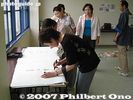
People sign their names on a washi sheet.
|
|
|

Spacious garden outside Fujii Hikoshiro house (in background)
|
|

Kitchen area with dirt floor.
|
|

There are also smaller sheets of paper where you can write a wish and sign your name. Paste will be applied to these sheets which will be used to fasten the bamboo frame to the giant paper.
|
|

Ducks
|
|

Pine tree in garden
|
|

Kitchen area
|
|

Ikoi no Mizube Park いこいの水辺
|
|

Spacious garden and Fujii Hikoshiro house
|
|

Furo bath wirth wooden barrel (heated by firewood)
|
|

The work proceeds.
|
|
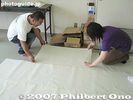
The last sheet is pasted and joined. The job was finished in 3 hours.
|
|
|

Changing room next to bath.
|
|

Western-style room
|
|

Path to next Omi merchant home.
|
|

The giant kite paper is finished, taking up the floor space of the entire room.
|
|
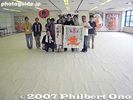
After every kite-making session, they take a picture of all the volunteer participants. It was very interesting. Anybody can participate on any day. Call the kite museum for schedule details: 0748-23-0081.
|
|

Statue of Fujii Hikoshiro
|
|

Turn left there.
|
|

Old photos of Omi merchants
|
|
|

July 16, 2007: Initial sketching and vermilion painting. A sketch of the design was made with a charcoal pencil. 下絵・墨
|
|

Old photos of Omi merchants carrying their trademark "tenbin" pole.
|
|

Former home of Omi merchant Tonomura Uhee (1777-1820) (外村 宇兵衛邸).
|
|

The giant kite's main and largest kanji character "sei" is painted in vermilion.
|
|

Western-style room
|
|

Entrance to former home of Omi merchant Tonomura Uhee.
|
|

A plastic bucket (the same kind used when you take a bath) with paint and a brush is used.
|
|

Record books
|
|

Inside former home of Omi merchant Tonomura Uhee. 玄関
|
|
|

Cherry blossoms and Ochiai River
|
|

May 27, 2007 was a bad day for giant kite flying in Yokaichi, as the giant kite crashes head-first into a bamboo grove on its first and last flight during the Yokaichi Giant Kite Festival.
|
|

Tags and certificates.
|
|

Inside former home of Omi merchant Tonomura Uhee.
|
|
|

Cherry blossoms and Ochiai River
|
|

At slightly past noon with medium-force winds, the giant kite is launched. The kite immediately went straight up. The giant kite is 13 meters high and 12 meters wide, and weighs 700 kg.
|
|

Furo bath made of wood.
|
|

Shopfront with shopkeeper's desk.
|
|

The red and ornage colors are painted first on the kite, while the black and gray colors are painted later.
|
|

Koi in Ochiai River
|
|

It flew very high, up to about 150 meters, then veered to the right, over our heads.
|
|

Signs
|
|

Shopkeeper's desk.
|
|
|
|

Ochiai River
|
|

Then it suddenly dove straight down and crashed head-first into the bamboo grove. Ironically, the blue banner on the left says, "Ganbatte" (Do your best).
|
|

Signs
|
|

Living room
|
|

Spots of white are made on purpose to give a brush stroke effect.
|
|

Higashikurume manhole
|
|

The giant kite was swallowed whole by the bamboo trees. No one was hurt. Also see my YouTube video here. 大凧が竹やぶに落下
|
|

Kitchen area
|
|

Bonsai plum and pine trees
|
|

The "yorokobu" or "ki" kanji is also painted on the same day.
|
|

All we could see were the kite strings.
|
|
|
|

Bonsai
|
|

The design sketch is being completed.
|
|

The sign says "Arigato gozaimasu" (Thank you). I guess the bamboo was hungry for a giant kite.
|
|

Shopkeeper
|
|
|

Plastic pails and brushes
|
|

This was the 2nd time in three years for the giant kite to meet a major accident. In 2005, the kite broke in half in the sky and crashed into a crowd of people below.
|
|

Shopkeep's desk
|
|

Bonsai plum trees
|
|

Vermilion paint
|
|

"So how does it look?" "It looks pretty bad, boss."
|
|
|
|
|

The sketch of the hawk is completed.
|
|

Members of the giant kite preservation society look on as the disappointing and heartbreaking situation is assessed.
|
|

Kitchen
|
|

Showcase
|
|

Hawk eye
|
|

Hanging on to the strings...
|
|

Storage area
|
|

Shopkeeper's record book.
|
|

Wing corner
|
|

As I expected, they soon started cutting down the bamboo.
|
|

Swing-down ladder to enter upper floor.
|
|

Shopkeeper's record book.
|
|

Local cable TV station also came to cover the kite-making progress.
|
|
|

A small clearing was made around the kite.
|
|

Attic, mainly for storage.
|
|

A brush stroke effect
|
|

Omi merchant profiles
|
|

No way would this guy be able to pull the kite out of this one...
|
|

Attic and ceiling
|
|
|
|

How he wished that he could just pull the strings to drag the kite out.
|
|

External view
|
|
|

Obata dolls 小幡人形
|
|

The kite strings were too tangled in the bamboo.
|
|

External view
|
|

"Yorokobu" or "ki"
|
|

Garden
|
|

A closer look at the accident scene. The kite suffered significant damage, and it took about 20 days to repair.
|
|

Garden
|
|
|

Tokonoma alcove
|
|

As I predicted again, they started disassembling the kite so they could roll (crumple) it up and carry it out. The kite was not flown again for this festival. It was to be its final flight since it will be replaced next year.
|
|

Garden
|
|
|

Carrying out bamboo. Many people left the festival after the kite crash.
|
|

More display cases
|
|

External view of house
|
|

Vermilion painting of "sei" is complete.
|
|
|

Stack of cut bamboo.
|
|

Statue of Omi merchant peddler carrying his trademark "tenbin" pole.
|
|

Group photo of those who worked on the kite this time. This session was 9:30 am to noon.
|
|

Medium-size kites entered in a kite-flying contest.
|
|
|
|

Rickshaws
|
|

July 31, 2007: Bamboo frame work and picture-edge frame work. 骨組(絵骨)Hone-gumi (Ebone)
|
|
|

Scenery along the route to the Omi Merchant Museum 15 min. walk away.
|
|

Way to the third Omi merchant house.
|
|

A diagonal grid of thin, rod-like bamboo criss-crossed the entire kite. They are now using string to tie the bamboo intersections.
|
|
|

Flower farm
|
|

Old mail box.
|
|

Tied bamboo intersections. The rod-like bamboo are supported by larger pieces of bamboo.
|
|
|

Cable TV notice.
|
|

Former home of Omi merchant Nakae Jungoro (中江 準五郎邸).
|
|

Kite edges are lined with a thicker bamboo to which the rod-like bamboo are tied.
|
|
|

Ohmi Merchant Museum is on the 3rd floor of this building. 近江商人博物館 Map
|
|

Former home of Omi merchant Nakae Jungoro (中江 準五郎邸).
|
|

This intricate bamboo frame supports the kite paper so it does not flap around like normal paper.
|
|
|

This is actually the Tenbin no Sato Culture Center. てんびんの里文化学習センター
|
|

Entrance to home of Omi merchant Nakae Jungoro (中江 準五郎邸).
|
|

The bamboo frame work is done after the kite design is painted.
|
|
|
| 1586 files on 7 page(s) |
1 |
 |
 |
 |
 |
|